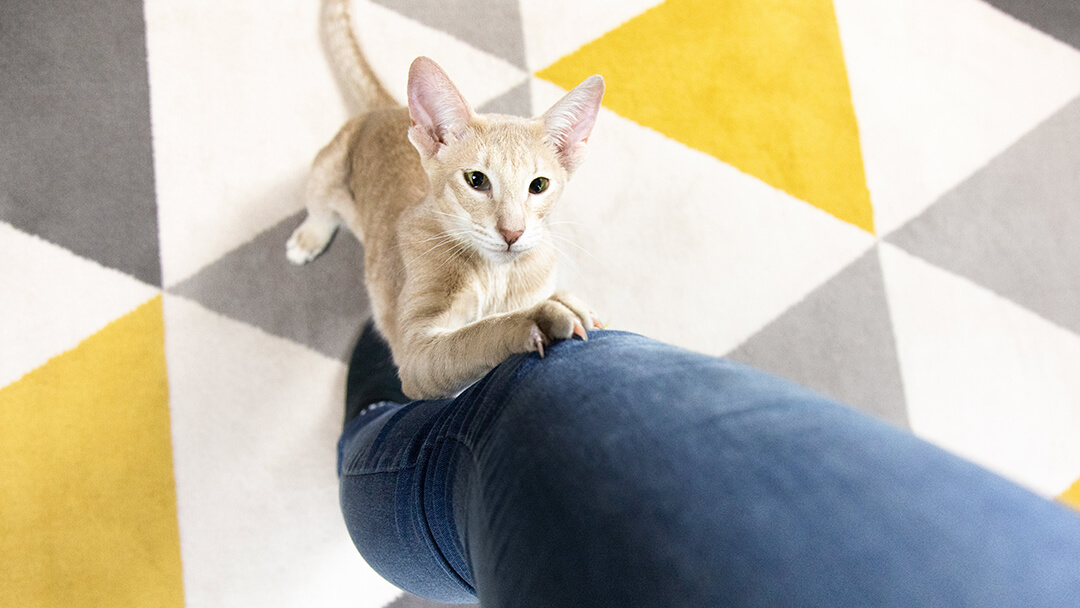

If you’ve noticed that your cat is having problems urinating, it may be down to feline lower urinary tract disease (FLUTD). This is a broad term that’s used to describe a number of urinary tract conditions that affect cats’ bladders and urethras.
The most common condition results in inflammation of the bladder (cat cystitis) and, in male cats, similar symptoms accompanied with an obstruction of the urethra (the tube from the bladder to the outside). This condition, known as idiopathic cat cystitis, is unfortunately both common and complex and, as symptoms can be medical and/or behavioural, you won’t always know exactly what’s triggered it.
Cats can get urinary problems which prevent the bladder from emptying properly and, when not treated quickly this could cause a blockage of the urethra. These urinary problems are most commonly caused by feline lower urinary tract disease (FLUTD). Unlike the name suggests, FLUTD is not actually a specific type of disease, but an umbrella term for conditions that affect the urinary bladder and/or urethra in cats.
Potential causes of feline lower urinary tract disease (FLUTD)
There are numerous issues that may cause FLUTD, some of the most common causes are:
Idiopathic cat cystitis
Idiopathic cat cystitis, the most common type of FLUTD, causes an inflammation in the bladder. Concentrated urine (common in cats), stress and damage to the lining of the bladder are all thought to contribute to the problem.
Although both male and female cats can get cat cystitis, tom cats have a narrower and longer urethra which can become blocked by leaked proteins and blood - this is a life-threatening complication which means the cat physically cannot urinate.
Bladder stones
Bladder stones are a less common problem in cats, but will cause similar symptoms to cat cystitis and can also cause a blockage of the urethra.
Anatomical abnormalities
If your cat has been in an accident, or was born was with any physical problems, then any resulting damage to their bladder or urethra could cause lower urinary tract problems.
Urinary tract infections in cats
A cat urinary infection is a more unusual cause of feline lower urinary tract disease in cats with no other health problems, although some cats with conditions like diabetes or kidney disease are generally more prone to infection.
Age or weight-related problems
FLUTD is most frequently found in middle-aged, overweight cats that live a sedentary indoor life and only use a litter tray.
Signs of FLUTD in cats
The signs feline urinary tract disease in cats can be both behavioural and medical, a few of the most common symptoms your cat may display are as follows:
- Going in and out of their litter tray repeatedly
- Urinating in unusual places around the house
- Straining to go to the toilet
- Pain when urinating (usually characterised by crying out when going to the toilet)
- Licking their genital area a lot more than usual
- Blood in their urine – it may appear pink or dark
- Producing little or no urine after straining
- Loss of bladder control (although this is rare)
- Lack of appetite
- Lethargy and reduced interest in regular activities
If your cat displays any of the symptoms listed above, seek veterinary help straight away. FLUTD can be a very serious and life-threatening condition so it’s imperative that it’s caught early.
Diagnosing FLUTD
Once your vet has run a few tests to rule out other causes, they’re most likely to diagnose your cat’s condition as idiopathic cat cystitis. They may still do blood tests, just to make sure your cat doesn’t have any underlying kidney problems or issues and take a urine sample. If further confirmation is needed, your vet may want to take x-rays and use an ultrasound to get a clearer picture of your cat’s bladder and urethra.
Treating FLUTD
Feline lower urinary tract disease and particularly idiopathic cat cystitis, can be tricky to treat and takes lots of patience and time, as well as possible help from a feline veterinary specialist or behaviourist. If your cat has a blockage in their urethra, your vet will need to act quickly to remove the blockage and possibly place a catheter (tube) into the urethra to allow the urine to pass. If it’s bladder stones then these may need to be removed surgically and sometimes followed up with a diet change.
However, the good news is that with veterinary help, many cats with urinary problems go on to have normal and happy lives. Some of the most common treatment options for cat cystitis and urinary issues are listed below:
Pain relief
FLUTD is often quite uncomfortable for your cat, and as pain can also cause the urethra to narrow further, pain relief is often prescribed.
Medication
Some drugs can be used to relax the urethra in male cats to try and prevent or treat blockages. Medication may also be recommended by your vet to improve your cat’s bladder wall lining.
Stress reduction
Stress is known to play a part in idiopathic cat cystitis so speak to your vet about anything that you think could be causing your cat stress, and how it can be avoided. Your vet might recommend speaking to a veterinary behaviourist or suggest synthetic pheromone treatments to help with any anxiety your cat might be feeling.
Reduction in the concentration of the urine
It’s extremely important that your cat eats a good PH balanced diet and drinks plenty of water. If your cat currently has a dry food diet, try switching them to wet food. If they’re already eating wet food, add a little water or give them ‘soups’ of tuna or chicken in plenty of water (without salt).
Increased water intake
Encourage your cat to drink more water by giving them plenty of sources of water, from cat water fountains to wide-brimmed bowls, in several locations inside and outside the house. Fill their water bowls right to the top so they don’t have to put their head deep into the bowl to drink. If you’re wondering how much water your cat should be drinking, read our guide.
Whatever the cause of the cat urinary tract infection, your vet should soon be able to prescribe a treatment to get your pet to their usual vibrant, happy selves again.
Featured products
Related articles














